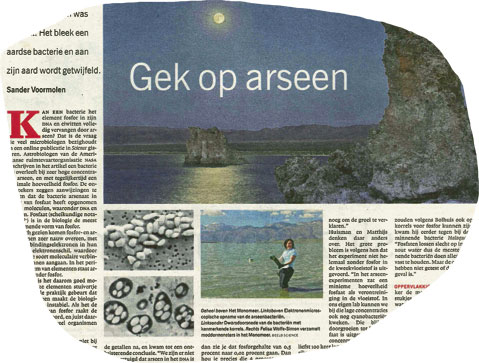“When I looked at the news last week, they said Nasa had made an important discovery on ‘another form of life’,” says Professor Gijs Kuenen, emeritus professor in biotechnology at the faculty of Applied Sciences. Friday, after a week of rumours, the news finally broke.
Science published the article, ‘A Bacteria that can grow by using Arsenic instead of Phosphorus’, by Dr Felisa Wolf-Simon.
Dr Wolf-Simon claimed that bacteria from arsenic-containing Mono Lake in California not only tolerated the normally toxic arsenic, but also that the bacteria use it instead of phosphor in proteins and DNA. This could make sense, because arsenic and phosphorus, being in the same column in the periodic table, are chemically similar. In other organisms, it’s the similarity that causes arsenic’s toxicity. An organism readily takes up arsenic as arsenate, but the resulting bio-molecules are unstable, causing all kinds of disruptions in the cells. Not so with the bacterium called GFAJ-1, the Nasa-sponsored researchers claim.
“The claim touches at the base of life,” says Dr Bertus Beaumont, evolutionary biologist at Applied Sciences. “All life we know uses phosphate-based DNA to encode the genetic information. If a form of life exists that uses another form of molecule to do this, then that would be a fundamentally other kind of life. That would be very interesting.” If the research paper’s conclusions hold true, the finding would however still have no direct bearing on the question of extraterrestrial life, other than making the point that phosphor may not really be essential for life to exist. But is it not?
Prof. Kuenen, who has worked with similar arsenic-resistant bacteria in his lab, thinks the news has been overhyped. He, like many others, is not convinced that the GFAJ-1 bacteria have built arsenate into their DNA. “They haven’t grown the bacteria in total absence of phosphate,” he says. “There is always some phosphate in the culturing medium. With the very little phosphate available, it looks like the bacteria have partially used arsenate instead. But the main question is: has arsenate been built into the DNA? And that, they haven’t proven.”
Bacteria that were grown on arsenate became 50 percent larger than normal, leading researchers to speculate the bacteria somehow have extra facilities to deal with the arsenic.
Prof. Kuenen explains that functioning DNA with arsenate instead of phosphate is hard to imagine. Arsenic is more chemically active, which would lead to more methyl groups on the DNA. Methyl groups are nature’s way of punctuation; they signal where DNA sequence reading starts and stops: ‘Get it. Wrong and you. Mess up the. Message.’
Dr Beaumont thinks the researchers have been too quick to publish. Prof. Kuenen can imagine that pressure has made the researchers and editors involved less critical than otherwise. He believes last week’s hype will motivate many others to follow in the same line of research. “Within a year, we will know exactly what is going on,” Prof. Kuenen expects. His own lab will probably not enter the race however due to lack of money and manpower.
Als vader of moeder een hbo-opleiding of universitaire studie heeft gevolgd, maken de kinderen meer kans om in het hoger onderwijs terecht te komen. Dat is nog altijd zo, maar die regel is niet meer zo hard als voorheen, blijkt uit het rapport Kennis in Kaart, dat het ministerie van OCW vandaag heeft uitgebracht.
Vroeger kwam bijna niemand op de universiteit terecht als zijn ouders hooguit de lagere school hadden afgemaakt. Dat lukte slechts twee procent van de leerlingen die in 1989 aan de middelbare school begonnen. Ze gingen net iets vaker aan het hbo, maar ook dat percentage bleef op zes procent steken. Tegenwoordig bereikt negen procent de universiteit en dertien procent het hbo. Dat blijkt uit cijfers van kansarme leerlingen die tien jaar later, in 1999, in de brugklas zaten.
Want de instroom in het hoger onderwijs is gegroeid. Steeds meer leerlingen halen de juiste papieren om naar een hogeschool of universiteit te gaan. Die trend heeft vooral effect op kinderen van lager geschoolde ouders.
Ook kinderen van ouders die niet verder waren gekomen dan de middelbare school of een mbo-diploma doen het beter. Van hen ging slechts vijf procent naar de universiteit, blijkt uit cijfers van de brugklassers uit 1989. Dat percentage is verdubbeld naar tien procent voor de brugklassers van 1999. Voor het hbo groeide het aandeel van negentien naar 23 procent.
Ook kinderen van hoogopgeleide ouders gaan vaker naar het hoger onderwijs, maar in deze groep is de groei minder spectaculair: van 26 naar 27 procent voor het hbo en van 20 naar 23 procent voor het wo.



Comments are closed.